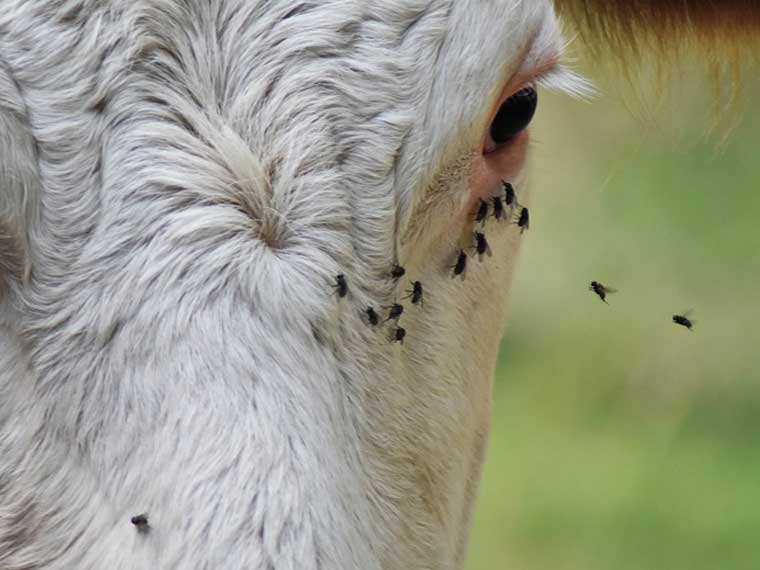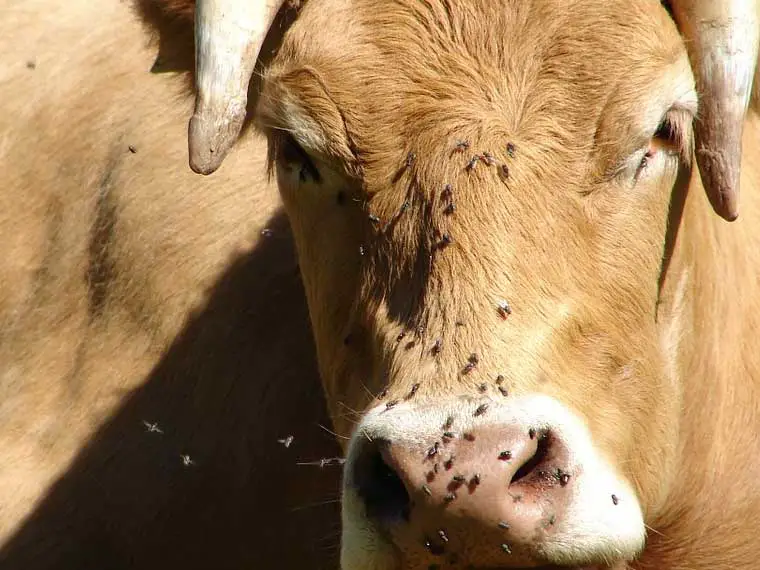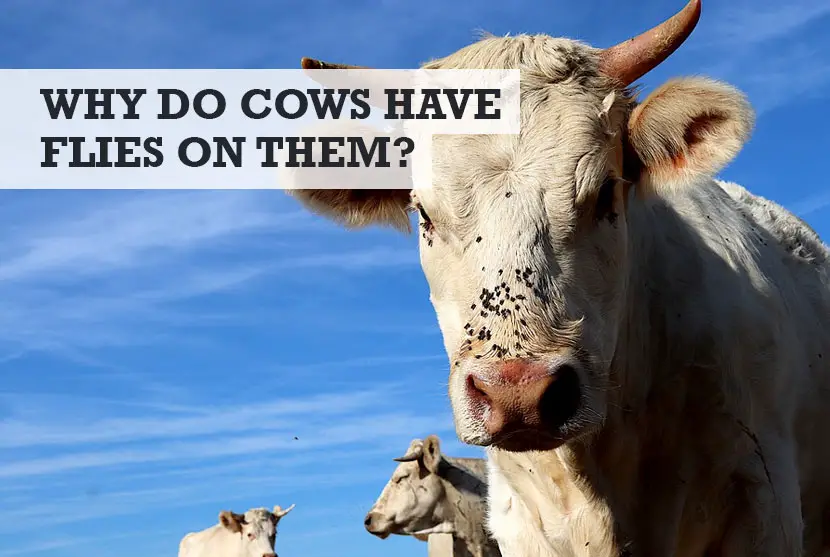If you’ve ever seen a cow up close you can’t fail to notice the flies that gather on them and around their eyes. If I was a cow, flies would bother and annoy me. But is that the same with our bovine friends. Here’s the truth about why cows always have flies on them.
Why do cows have flies on them? Cows have flies on them and around their eyes as flies are attracted to various secretions. This can include cow’s tears, urine, blood, and milk as well as any wounds on the cow’s body.
Any dairy or beef producer will agree that flies on their herds are a huge problem. The fly species that sit on cows are anything but harmless – they aren’t the usual house flies.
The types of flies that are attracted to cows tend to be horn and face. These two species are biting flies and use piercing mouthparts to suck blood from your cow’s exposed skin.
Below you can find more information about the blood-sucking flies that are annoying your cows and causing them more discomfort than you might think. If you have cattle herds, you’ll know that an unhappy cow can have a drastic effect on your bottom line.
When you see a cow with flies around their eyes, it’s important to understand that animal is not only unhappy but in pain! I’ve answered a few of the most common questions related to cows suffering from a fly problem.
Why do cows have flies around their eyes?
The main reason flies always seem to be around a cow’s eyes has to do with the species of the fly. Blood-sucking horn and face flies have piercing mouthparts which they use to rip and penetrate the cow’s skin around the face and body.

Believe it or not, each fly performs between 30 to 40 painful bites daily.
You can imagine how annoying flies like this will be to cows.
These files stay on the cow for most of its life cycle. They only move to lay eggs on fresh manure. Once the maggots (baby flies) hatch they also relocate to the surrounding cows.
Why are flies bad for cows?
The flies that sit on cows are biting flies. Unlike house flies, they don’t just sit around or lay eggs. Biting flies bite, causing the cow pain. Biting flies also spread bacterial and viral diseases which can be fatal.
Additionally, cows spend a great deal focusing on getting rid of the flies. They stomp, swat and shake themselves. This reduces the time they spend on grazing which leads to weight loss and increased energy expenditure.
For dairy cows, this also leads to a decrease in milk yields.
Types of flies that sit on cows
While cattle can be hindered by all the different fly varieties, two species are the most common found on cows.
- Horn fly: Horn flies are ordinarily found in clusters on the backs of cows. These horn flies feed on the blood of animals, having as many as 40 blood meals throughout the day. The female of the species lays their eggs in fresh manure where the eggs hatch into maggots which in turn grow into more horn flies.
- Face fly: These insects are named for the places they like to congregate – on the faces of cattle. They feed on secretions around the nose, eyes and mouths of cattle and spread infectious bacteria to these animals. The most common is bovine pink eye.
Diseases cows can get from flies
Aside from being an irritation to cattle, biting flies are also carriers of a whole host of different diseases. As each horn fly can bite an animal at least 40 times per day, the risk of disease is highly increased.
The most common diseases spread from fly bacteria to cows are listed below:
- Moraxella bovis: Also known as Bovine pink eye, this eye infecting bacteria can easily be spread between animals.
- Bovine leukosis: This is a blood-borne disease where the virus attacks white blood cells. It’s a leukemia-like viral disease that’s malignant.
- Anaplasmosis: Although this disease is generally spread by ticks, it can also be spread by flies who have the bacteria. It’s highly infectious and can be fatal to cattle.
You can find a more extensive look at the types of flies and their diseases, by clicking here.
How you know if a cow is bothered or annoyed by flies?
Contrary to common belief, cows do mind flies on them. Cows find flies annoying and bothersome. The flies that sit on cows are biting flies and have pre-stomal teeth.

Continued bites from these flies cause severe irritation, pain and varying infections. The most common symptoms that show your herd is annoyed by flies will be swishing of tails and stomping of feet.
Handy Hint: Have you ever wondered why cows stare at you?
How do you get rid of flies on cattle?
Knowing a little more about the flies that are creating your cow’s discomfort is only part of the solution. Fortunately, there are several things you can do to minimize the risk.
While flies are notorious for adapting to their environment, you might not get rid of them completely. Some standard measures will go a long way toward providing your animals with some relief.
Here’s how you can get rid of flies on cattle.
1. Fly-tags
One of the more effective measures in your fly control arsenal should be fly tags. Modern fly tags contain a considerably higher concentration of insecticide that is quite effective at controlling harmful fly populations.
Generally, most adult animals require two tags per animal and only one tag per calf. Tags last 3-5 months. Be sure to follow the manufacturer’s instructions.
2. Pour-on
Pour-on is usually done at the same time you tag the cows. The best time would be at the begging of spring. These types of medications are very effective against horn flies.
3. Sprays
Sprays are very effective throughout the year. Spray the barns where the animals sleep to minimize their exposure to flies.
4. Dust bags/cattle rubs
One of the most economical methods of fly control is the use of dust bags or rubs. Place it central to where all cattle pass, which will work well toward keeping the flies at bay.
5. Insect growth regulator
Another effective method for fly control is feeding cows a larvicide or insect growth regulator. Start 30 days before spring and continue use until 30 days after the first frost.
6. Clean barns
It’s important to keep cattle barns completely sanitized. Use fly sprays and fly traps to keep harmful fly populations away from the barns or sheds.
I’ve included a simple video to show you just how to control flies on your cattle.
Why do flies stay around cow’s eyes?
Face flies feed on the tear flow from the cows’ eyes. These pests use an abrasive mouthpart to cause the cow’s tear ducts to become active and leak. In short, they’re attacking the cow’s tear ducts!
Since it’s difficult to spray medicine on a cow’s face area without getting any in the eyes, face flies are among the most difficult pasture pests to deal with.
Does garlic keep flies off cattle?
One of the more natural approaches to flies on cows is garlic. Since garlic is known to deter flies, feeding your cows with garlic allows the cow to emit the garlic odor through their breath and skin.
Doing this creates some resistance to flies. It’s a safe-to-use option that’s compatible with both organic and grass-fed diets.
Can flies kill cows?
Flystrike (also referred to as myiasis) happens when flies lay their eggs on newborn or small calves.
Shortly after laying the eggs, maggots hatch from the larvae. Maggot’s burrow into the newborn calves’ skin, multiply and create toxic shock.
When this happens, the young livestock can die within 24-hours if not treated immediately.
When should you spray cows for flies?
To achieve maximum fly control, sprays and pour-on medications should be applied every two to three weeks throughout the fly season. Spraying sessions can be increased if there seem to be more flies in the area than usual.
Fly sprays should also be sprayed on newborn calves.
Conclusion
To conclude, flies around a cow’s face and eyes aren’t a benign issue, but can actually be very annoying and harmful to cattle.
You might also like…
- How cows show love and affection to humans
- Safe veggies that cows can eat
- The truth about cows sitting down in the rain
Photo of annoying flies on a cow’s face via https://pixabay.com/photos/cow-ruminants-farm-animals-horns-5470922/

